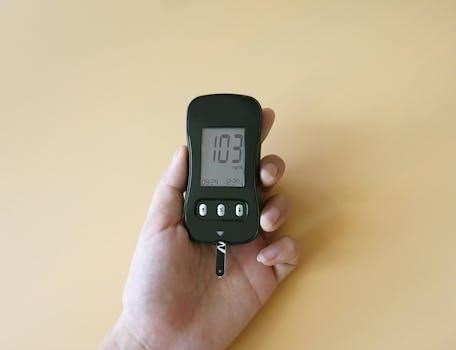Life Brand Blood Pressure Monitor⁚ Understanding Your Manual
Congratulations on purchasing your Life Brand blood pressure monitor! This manual provides essential guidance for accurate and reliable readings. Carefully review all instructions before use. It details setup, proper cuff application, interpretation of results, and troubleshooting. Understanding this manual ensures optimal functionality and extends the device’s lifespan.

Overview of Life Brand Blood Pressure Monitors

Life Brand offers a variety of blood pressure monitors designed for home use, providing convenient and accurate readings. These monitors utilize oscillometric technology, a non-invasive method of measuring blood pressure through the vibrations caused by arterial pulse. Models include upper arm and wrist monitors, catering to different user preferences. Upper arm monitors, like the LB BPM Upper Arm 12, often feature larger displays and cuff position control for added accuracy. Wrist monitors, such as the LB BPM Wrist 6.0, are compact and portable. Many Life Brand monitors also include features like irregular heartbeat detection, memory storage for multiple users, and date/time functions. Some models are compatible with smartphone apps, allowing users to track their readings over time. It’s essential to choose the right model based on individual needs and preferences, always ensuring the cuff fits properly for the most accurate results. Life Brand monitors are engineered to be user-friendly, with step-by-step instructions and clear displays, making blood pressure monitoring at home simple and reliable.
Key Features of Life Brand Monitors
Life Brand blood pressure monitors boast several key features designed for user convenience and accurate readings. Many models include an extra-large, blue-lit display, making it easy to view results, especially for those with visual impairments. Cuff position control is another important feature, ensuring the cuff is correctly placed for accurate measurements. Hypertension classification indicators provide a visual guide to understand blood pressure readings based on World Health Organization guidelines. Irregular heartbeat detection is a standard feature, alerting users to potential heart rhythm issues. The monitors also offer memory storage for multiple users, often ranging from 30 to 120 readings, facilitating long-term tracking. Some models include time and date functions, and an averaging feature that calculates the last three readings. Battery life indicators prevent unexpected power loss during measurements. Certain Life Brand monitors are compatible with downloadable smartphone apps like HealthCoach, enabling users to easily monitor and share their readings. Overall, these features aim to enhance the user experience, making blood pressure monitoring simple and effective.
Using Your Life Brand Monitor⁚ Step-by-Step Guide
To begin using your Life Brand blood pressure monitor, start by ensuring the device is powered by inserting the provided batteries or connecting an AC adapter if applicable. Next, securely apply the cuff to your upper arm or wrist, depending on the monitor model, following the guidelines provided in the manual. Sit comfortably with your feet flat on the floor and your back supported. Your arm should be resting on a flat surface at heart level. Once properly positioned, press the start button to initiate the measurement process. The cuff will inflate automatically, and the monitor will display the systolic and diastolic pressure readings along with your pulse rate. It’s crucial to remain still and quiet during the measurement for accurate results. After the reading is complete, the monitor will display the results, and some models will store the reading in memory for future reference. If using a wrist monitor, ensure the device is positioned at heart level during measurement; Always consult your monitor’s instruction manual for specific details.
Cuff Application and Proper Placement
Correct cuff application is essential for accurate blood pressure readings with your Life Brand monitor. For upper arm models, position the cuff on your bare upper arm, typically about one inch above your elbow crease. The artery marker on the cuff should align with your brachial artery, usually on the inside of your arm. Ensure the cuff is snug but not too tight; you should be able to insert one finger under the cuff. For wrist monitors, wrap the cuff around your wrist, ensuring the display faces upwards and the sensor is on the inside of your wrist. Secure the cuff snugly but comfortably. Improper cuff placement can lead to inaccurate results. For both types of monitors, it is crucial that your arm is supported and at heart level during measurement. Using an improperly sized cuff can also affect accuracy. Refer to your manual for specific guidelines on cuff size and placement for your particular Life Brand blood pressure monitor model. Always maintain the correct posture for each reading.
Understanding the Display and Readings
Your Life Brand blood pressure monitor displays several key readings. The most prominent are the systolic and diastolic blood pressure values, usually shown in mmHg (millimeters of mercury). The systolic reading represents the pressure in your arteries when your heart beats, while the diastolic reading indicates the pressure when your heart rests between beats. The monitor also displays your pulse rate in beats per minute. Some models feature a hypertension classification indicator, which categorizes your reading based on established guidelines. An irregular heartbeat detection symbol may appear if the monitor detects an irregular rhythm during measurement. Some advanced models also display date and time. Ensure you understand all the symbols and indicators on your specific monitor’s display. A clear and easy-to-read display is essential for proper monitoring and record keeping. Regularly check the display to become familiar with the information presented after each measurement. If necessary, refer to the included manual for a comprehensive guide on display functions.
Systolic and Diastolic Pressure Interpretation

Interpreting your systolic and diastolic blood pressure readings is crucial for effective health monitoring. Systolic pressure, the higher number, measures the force exerted on your arteries when your heart contracts. Diastolic pressure, the lower number, reflects the pressure when your heart relaxes between beats; A typical healthy blood pressure reading is often considered to be around 120/80 mmHg. Readings above this may indicate pre-hypertension or hypertension, while readings below may indicate hypotension. It’s important to understand that blood pressure fluctuates throughout the day, influenced by various factors like stress, activity, and even time of day. Therefore, taking multiple readings at different times can provide a more comprehensive picture. Consult your healthcare provider to determine the appropriate target range for your individual health profile. They can offer guidance on lifestyle modifications or medication if necessary. Regularly tracking your blood pressure readings and discussing them with your doctor is essential for managing your cardiovascular health effectively.
Irregular Heartbeat Detection and What It Means

Many Life Brand blood pressure monitors are equipped with irregular heartbeat detection technology, which can be a valuable tool in monitoring your cardiovascular health. This feature identifies deviations from a normal heart rhythm during a blood pressure measurement. If your monitor detects an irregular heartbeat, it will often display a specific symbol or indication on the screen. It’s important to note that occasional irregular heartbeats are not uncommon and can be caused by factors such as stress, caffeine, or dehydration. However, frequent or persistent irregular heartbeats should be taken seriously and discussed with your healthcare provider. The monitor is designed to detect these irregularities, but it is not a substitute for a professional medical diagnosis. An irregular heartbeat could be a sign of underlying conditions like atrial fibrillation, which requires proper medical evaluation. If you see the irregular heartbeat indicator frequently, consult your doctor to determine the cause and appropriate treatment. Regular monitoring can help you and your doctor make informed decisions about your heart health.
Memory Function and User Settings
Life Brand blood pressure monitors often include a useful memory function to help you track your readings over time. This feature allows you to store multiple blood pressure measurements, along with the date and time they were taken. Many models support multiple user profiles, enabling several individuals to use the same monitor while keeping their data separate. The memory function typically stores a set number of readings, and once full, it may overwrite the oldest data. User settings may include the ability to set the date and time, switch between different units of measurement, and potentially adjust other display parameters. Refer to your specific model’s manual for detailed instructions on accessing and navigating through the memory function and user settings. Understanding how to use these features can help you monitor your blood pressure trends effectively and share accurate data with your healthcare provider. Regular use of the memory function ensures you have a historical record of your blood pressure readings, aiding in comprehensive health management. Always consult the product manual to maximize the benefit of this feature.
Troubleshooting Common Issues
If you encounter issues with your Life Brand blood pressure monitor, there are several troubleshooting steps you can take before seeking professional assistance. Common problems include error messages on the display, inaccurate readings, or the device not powering on. First, ensure the batteries are correctly installed and have sufficient charge or that the AC adapter is properly connected. Check that the cuff is applied correctly and securely to your arm, following the instructions in the manual, as improper cuff placement can lead to inaccurate readings. If you receive an error message, consult the manual for specific troubleshooting advice related to that error code. If the monitor isn’t powering on, try replacing the batteries with new ones. For inaccurate readings, make sure you are relaxed and have not eaten, exercised or smoked recently. If problems persist, check the unit’s specifications and ensure you are using the right size cuff. Finally, if all troubleshooting steps fail, contact the manufacturer or a local service agent for further assistance, ensuring you are aware of the warranty and service options available.
Warranty and Service Information
Your Life Brand blood pressure monitor comes with a warranty against defects in materials and workmanship, typically excluding the cuff, batteries, AC adapter, and any optional accessories. The specific warranty period varies, so it’s essential to consult your product’s documentation or the manufacturer’s website for precise details. If your device malfunctions within the warranty period, contact the manufacturer or the retailer from where you purchased the monitor to initiate a warranty claim. Be prepared to provide proof of purchase and a detailed description of the issue you are encountering. For service or repairs outside of the warranty period, you may need to contact a local service agent authorized by the manufacturer. Remember to only use specified accessories and parts, as using third-party items may void the warranty. Always refer to the manufacturer’s guidelines for proper care and maintenance to extend the life of your monitor. If you are unsure about anything consult the manual.

